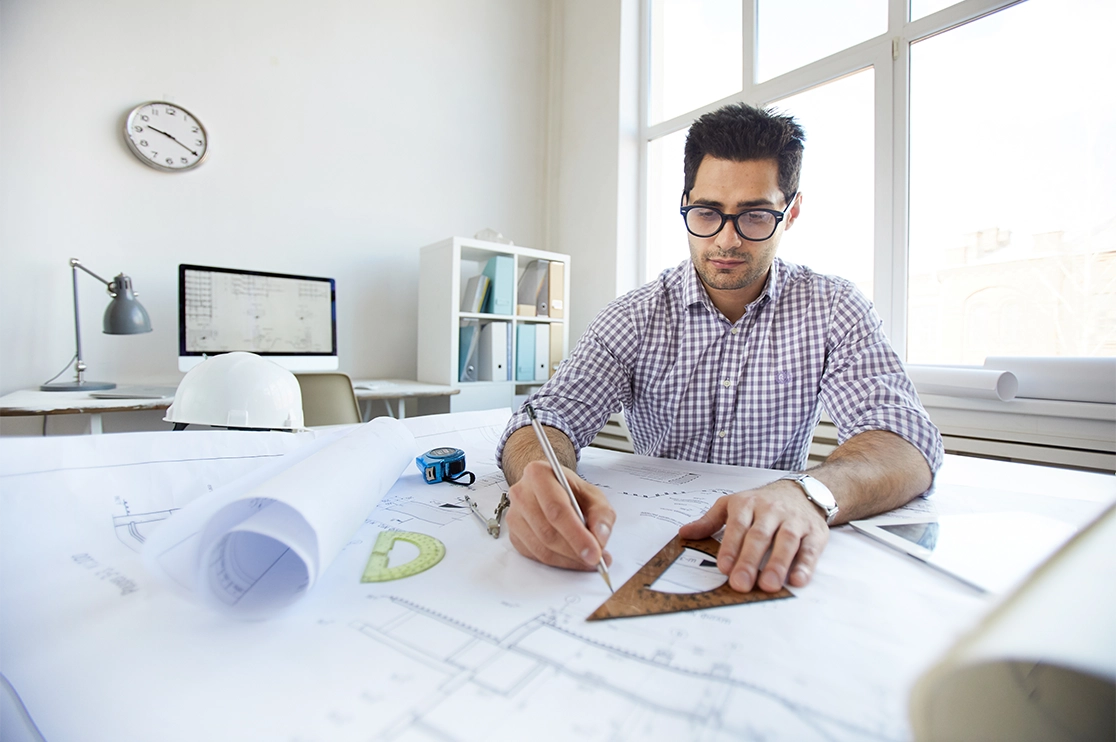Recognizing the Diverse Career Paths Available for Aspiring Architect
As an ambitious Architect, you have a world of career courses awaiting you. Each course offers special difficulties and chances to use your creative thinking and technical expertise. Whether you're attracted to typical style or the subtleties of sustainable style, there's a niche that lines up with your interests. Comprehending these diverse alternatives can form your specialist journey, however which instructions will you select to discover initially?
Traditional Design: Designing Structures and buildings
Typical style focuses on creating structures and structures that mix functionality with visual allure. As you discover this area, you'll appreciate the detailed balance in between form and purpose. You'll discover to draw inspiration from historical designs, integrating components like proportion, products, and workmanship. Your designs can reflect cultural heritage, showcasing neighborhood practices while satisfying modern demands.
You'll develop skills in composing, model-making, and site analysis, permitting you to imagine and communicate your concepts properly. Engaging with clients, you'll require to comprehend their vision and convert it right into practical designs.
In addition, constructing codes and sustainability practices are important in your job, guaranteeing your frameworks are environmentally pleasant and risk-free. As you expand in your occupation, you'll discover opportunities in property, industrial, or even remediation jobs, each offering distinct obstacles. Accepting standard design leads the way for a meeting profession that pays homage to the past while forming the future.
Urban Preparation: Shaping Neighborhoods and Public Spaces
As an aspiring Architect, you can play an essential duty as an urban planner, changing exactly how neighborhoods operate and interact. By using neighborhood interaction techniques, you'll guarantee that citizens have a voice in shaping their environment. And also, incorporating lasting style principles will certainly assist develop spaces that not just satisfy today's needs but additionally secure the future.
Duty of Urban Planners
While several could consider architects as the sole enthusiasts behind structures, urban coordinators play an important duty in shaping the more comprehensive landscape of communities and public areas. They examine land use, zoning regulations, and neighborhood needs to produce lasting settings that improve top quality of life. By teaming up with different stakeholders, you'll aid create parks, transportation systems, and domestic areas that promote social interaction and ease of access. Urban coordinators additionally focus on ecological considerations, guaranteeing that developments integrate green areas and assistance biodiversity. Your competence in spatial layout and community characteristics permits you to picture future development while preserving social heritage. In this important duty, you'll directly influence exactly how individuals experience their environments, making every project an opportunity for favorable change.
Area Interaction Strategies
Reliable area engagement approaches are vital for city coordinators to ensure that the voices of locals are heard and valued in the planning process. To foster meaningful dialogue, you must prioritize open forums and workshops where community members can express their ideas and concerns. Usage surveys and social networks to get to a more comprehensive audience, making sure diverse point of views are consisted of. Teaming up with regional organizations can enhance count on and help with deeper connections. It is very important to offer clear details regarding proposed jobs and decision-making processes, enabling homeowners to feel informed and equipped. By proactively listening and integrating feedback, you'll create rooms that show the neighborhood's demands, eventually bring about even more effective and lasting metropolitan environments. Embrace transparency and continual dialogue for long lasting influence.
Sustainable Style Concepts
When developing metropolitan areas, including sustainable layout concepts is critical for creating settings that thrive both ecologically and socially. You should start by focusing on power effectiveness, utilizing products that reduce waste and advertise recycling. Think about integrating environment-friendly spaces, like gardens and parks, to improve biodiversity and improve air top quality. Advertising walkability and public transport can minimize reliance on vehicles, promoting a much healthier area.
Designing with water preservation in mind is likewise vital-- assume concerning rain yards and absorptive surface areas to handle stormwater. Entailing neighborhood members throughout the planning procedure warranties that the rooms you develop meet their needs and motivate social interaction. By embracing these principles, you'll add to vivid, lasting urban landscapes that benefit everyone.

Landscape Style: Developing Sustainable Exterior Settings
As you discover landscape design, you'll find important layout principles that develop functional and beautiful outdoor rooms. Lasting techniques play a vital role in ensuring these environments thrive while reducing ecological effect. Plus, you'll locate a variety of profession chances that enable you to make an actual distinction in just how people communicate with nature.
Design Concepts in Landscape
Recognizing style principles in landscape style is necessary for producing lasting outdoor environments that balance with nature. You'll need to consider aspects Full Report like equilibrium, range, and percentage to assure your layouts feel cohesive and inviting. Integrating indigenous plants not just boosts biodiversity however additionally minimizes water use, making your landscape resistant. Think of the circulation of space and exactly how people connect with it; pathways and seating areas need to welcome exploration and leisure. In addition, take note of seasonal changes, making with products that complement the environments year-round (Architect). By focusing on sustainability and appearances, you can develop outdoor areas that enhance the community and promote wellness. Accepting these principles will set a strong foundation for your profession in landscape architecture.
Sustainable Practices Summary
Lasting techniques in landscape style not only concentrate on appearances but additionally focus on ecological health and wellness and source preservation. You can create spaces that promote dirt health, such as exercising and making use of organic products permaculture concepts. Eventually, these practices ensure your layouts benefit both people and the setting for years to come.
Profession Opportunities Exploration
With a strong foundation in sustainable methods, landscape architecture supplies a variety of occupation paths that allow you to make a purposeful impact on the atmosphere. Urban organizers often collaborate with landscape architects to produce green areas in city settings, boosting city livability. If you're enthusiastic concerning education and learning, consider coming to be a landscape style teacher, inspiring future generations.
Lasting Layout: Focusing on Eco-Friendly Practices
As you discover your profession in design, welcoming green techniques can establish you apart in an affordable area. Lasting layout focuses on producing structures that reduce environmental influence while boosting resident wellness. By incorporating sustainable products, energy-efficient systems, and sustainable building methods, you'll add to a greener future.
Beginning by obtaining knowledge of eco-friendly qualifications like LEED or BREEAM, which can bolster your credentials. Consider exactly how natural light, air flow, and thermal efficiency can maximize design. Work together with designers and environmental specialists to innovate services that minimize waste and save sources.
Do not forget the significance of neighborhood involvement-- engaging neighborhood stakeholders can inspire layouts that harmonize with the atmosphere. As customers significantly focus on sustainability, your proficiency in eco-friendly techniques will certainly not only draw in jobs but additionally accomplish your interest for liable design. Accept this vital aspect of the occupation, and enjoy your profession prosper.
Historical Conservation: Protecting and Restoring Social Heritage
While you begin on your building journey, take into consideration the necessary role of historical conservation in maintaining our cultural heritage. This field concentrates on the defense and reconstruction of significant structures, sites, and structures that tell the stories of our past. By taking part in historic conservation, you'll assist guard the architectural legacy that forms neighborhood identification.
As a historic preservation Architect, you'll evaluate historical significance and evaluate the condition of structures. You'll function carefully with conservationists and historians to guarantee authentic remediation strategies are employed. This profession path enables you to mix creativity with research, enabling you to develop options that appreciate original materials and workmanship.
Your job not only adds to sustainability by recycling existing structures however additionally cultivates a sense of satisfaction within areas. Embracing this course will aid you come to be a guardian of background, preserving the stories and appearances that improve our lives.
Interior Design: Enhancing Indoor Spaces
Historical conservation and interior architecture both share a dedication to enhancing the built atmosphere, however they concentrate on various aspects. While historic conservation highlights preserving a structure's historic and cultural worth, interior architecture nos in on maximizing click here to find out more indoor rooms for performance and aesthetic appeals.
As a hopeful Architect, you'll discover that indoor design enables you to blend creative thinking with technological abilities. You'll create rooms that not just look excellent but likewise advertise comfort and effectiveness. This field involves recognizing exactly how light, shade, and materials interact within a room, affecting mood and use.
You'll service numerous jobs, from residential homes to commercial workplaces, ensuring that each atmosphere satisfies the needs of its occupants. By prioritizing customer experience, you can transform interiors into useful and motivating areas, making a substantial effect on that site how individuals communicate with their surroundings. Accept the possibility to improve interior environments and form the means individuals function and live.
Industrial Design: Combining Performance With Aesthetics
Industrial design plays an important function in developing products that effortlessly mix visual appeals with performance, ensuring that what you make use of everyday is not only visually enticing however likewise practical. As an ambitious Architect, you can involve yourself in this area, concentrating on designing every little thing from furniture to customer electronics. Your job includes understanding individual demands, materials, and making processes, enabling you to develop ingenious options that improve daily experiences.
In industrial layout, you'll usually team up with designers, marketing professionals, and makers, making certain that your styles are not just stunning yet additionally viable. You'll find out to stabilize type and feature, prioritizing use without giving up style. By refining your skills in laying out, 3D modeling, and prototyping, you'll be well-equipped to bring your ideas to life. This occupation path uses a dynamic atmosphere where creative thinking meets practicality, making it a rewarding choice for engineers thinking about forming the items of tomorrow.
Frequently Asked Questions
What Educational Accreditations Do I Required to End Up Being an Engineer?
To end up being a designer, you'll need an expert level in style, commonly a Bachelor's or Master's. In addition, you'll have to complete an internship and pass the Architect Registration Evaluation to practice lawfully.
Exist Certification Needs for Various Architectural Job Paths?
Yes, there're qualification needs for various building courses. Architect. You'll need to pass examinations, full teaching fellowships, and in some cases pursue specialized training, depending on your picked emphasis, like landscape architecture, metropolitan style, or historic preservation
What Software Skills Are Essential for Designers Today?

Just How Can I Gain Practical Experience While Examining Style?
You can gain useful experience by interning at architectural companies, joining style competitors, volunteering for neighborhood projects, or working together with classmates on real-world tasks. These chances improve your skills and construct valuable links in the sector.
What Work Opportunities Exist Outdoors Standard Architecture Firms?
You can explore different work chances outside conventional architecture companies, like city preparation, interior style, landscape style, building monitoring, property advancement, and even duties in sustainability consulting. Each offers one-of-a-kind difficulties and rewards.
Whether you're attracted to traditional design or the subtleties of sustainable layout, there's a particular niche that straightens with your passions.When making city spaces, incorporating sustainable layout concepts is crucial for developing settings that thrive both environmentally and socially.As you discover landscape style, you'll uncover crucial layout concepts that develop useful and gorgeous outside rooms.Understanding style concepts in landscape style is important for developing sustainable outdoor atmospheres that balance with nature.In commercial design, you'll frequently work together with marketing professionals, engineers, and manufacturers, making sure that your styles are not just beautiful but additionally possible.
Comments on “Architect Marketing Strategies to Reach High-End Clients”